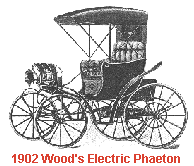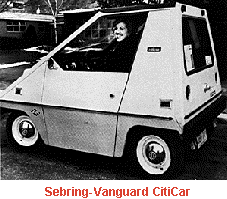The principles behind electric cars are pretty straightforward - your car has a battery, you charge it up, the battery powers the car.... simple as that! However, slightly more detail might be useful. As with most things, the best place to start is the beginning so here is a little bit of the history of the electric car...
The Origin of Electric Cars

The electric car was right up there in the forefront of the automotive revolution over a hundred years ago. At the start of the 20th century steam,electric, and gasoline were fairly equally popular and with no smell, vibration, or noise, and greater ease of use, the future was looking good for the electric vehicle. Steam powered cars were always going to struggle as they took over 40 minutes to build up the head of steam required to go anywhere! And early gasoline cars were quite physically awkward with a hand crank needed to start and an unwieldy gear shifter. So what happened?
The Discovery of Oil and the Electric Car

Electric car usage continued to increase until around 1912, after which a number of developments conspired to see the electric car almost forgotten about for the best part of half a century. As the car revolution started to come of age, the road networks and therefore the distances people wanted to travel began to increase - leaving the limited range of the electric cars of the time... well... limited. In tandem with this, Henry Ford started mass-producing gasoline cars at around half the price of electric cars, and the gas car began to get more user friendly with electrical starter motors eliminating the hand crank.
The killer blow for electric vehicles however, was the discovery of OIL - particularly in Texas - which made gasoline widely available and easily affordable by the average consumer. The discovery of oil changed the face of car technology forever.
It was this discovery of oil that also caused the redesign of the vegetable oil engine to take diesel instead - only now this appears to be coming full circle with chip shops around the world suddenly finding their waste vegetable oil an increasingly valuable commodity!
Electric Cars in the 1960s and 1970s

1970s Electric CarIt wasn't until the 60's and 70's that electric vehicles started to pop up on peoples' radars again. It started to become clear that oil based fuel perhaps wasn't as great as it had first appeared.
People started to realise that oil would not in fact last forever and had a good number of negative issues associated with its use - not least were issues to do with political dependence on oil imports and the environmental damage being caused by so many cars burning gas.
The 70's finally saw the re-emergence of electric cars aimed at the consumer market with the Sebring-Vanguard CitiCar and the Elcar Corporation's Elcar being the main players. A number of electric vans were produced for various purposes but limited range and the continued relative cheapness of oil prevented any real take-up of the still fledgeling technology. By the 70's and 80's petrol and diesel car technology had become so prevalent and advanced that the task facing electric car alternatives to break into the automotive markets was now a very big ask.
Electric Cars in the 21st Century

Now, however, what twenty years ago seemed like an un-climbable mountain is beginning to seem like a very realistic proposition after all. Soaring oil prices coupled with large scale political and social acceptance of the environmental damage caused by petrol and diesel cars, in addition with improving technological innovations such as lithium-ion batteries, is starting to push electric cars back into the limelight.
Co-founder of Tesla Motors, Elon Musk has been quoted as saying that in 30 years time he thinks the majority of cars in the US will be electric. So maybe it will all come full circle? Now onto the science bit....
As electric cars get more plentiful, so will recharge points. The power from the battery is used to drive an electric motor which in turn moves the electric car. There is usually a 'controller' involved too which regulates both the power sent from the battery to the electric motor, but also often the rate at which the recharging process occurs.
AC versus DC and the Electric Motor
The earliest and simplest electric car technology tended to use DC current to power the electric motor - DC (Direct Current) means the current flows in one direction all the time. DC is cheaper and more straightforward to use. AC - Alternating Current - means the electrical flow fluctuates from one direction to the next, usually at around 50 times per second. AC power can drive an induction motor which can operate more efficiently and powerfully as well as offering maintenance benefits. AC power requires the use of an inverter to convert the DC power from the battery into AC and a controller to regulate the motors speed.
Regenerative Braking and the Electric Car
A common theme within electric cars and other vehicles is the use of regenerative braking. In normal braking the car is slowed down essentially by converting the forward energy of the car into friction (i.e. kinetic energy is converted to heat energy which is why brake pads heat up and turn red!).
The escence of regenerative braking means that as you apply the brakes instead of the energy being completely lost to friction and heat, some of the energy is re-captured and stored. Obviously there is still loss of energy when you brake even with regenerative braking, but it is one of many techniques for trying to increase the efficiency of electric cars.
Electric Car Batteries
There are lots of different types of batteries which can be used to power electric vehicles - these include lead-acid batteries, nickel-cadmium or ni-cad, nickel metal hydride (Ni-MH), Lithium-ion (Li-ion), and Lithium-polymer. Lead acid batteries are by far the most common and most mature technology battery-wise, but although they have a good track record when it comes to reliability they tend not to offer as good or efficient performance as some of the newer types of battery.
New batteries are by no means simple alternatives though - ni-cad batteries have actually been banned in the EU, while there are well documented problems with Lithium-ion batteries catching fire spontaneously (for example as happened to Sony when they were forced to recall about a million laptops).
 The electric car was right up there in the forefront of the automotive revolution over a hundred years ago. At the start of the 20th century steam,electric, and gasoline were fairly equally popular and with no smell, vibration, or noise, and greater ease of use, the future was looking good for the electric vehicle. Steam powered cars were always going to struggle as they took over 40 minutes to build up the head of steam required to go anywhere! And early gasoline cars were quite physically awkward with a hand crank needed to start and an unwieldy gear shifter. So what happened?
The electric car was right up there in the forefront of the automotive revolution over a hundred years ago. At the start of the 20th century steam,electric, and gasoline were fairly equally popular and with no smell, vibration, or noise, and greater ease of use, the future was looking good for the electric vehicle. Steam powered cars were always going to struggle as they took over 40 minutes to build up the head of steam required to go anywhere! And early gasoline cars were quite physically awkward with a hand crank needed to start and an unwieldy gear shifter. So what happened?
 Electric car usage continued to increase until around 1912, after which a number of developments conspired to see the electric car almost forgotten about for the best part of half a century. As the car revolution started to come of age, the road networks and therefore the distances people wanted to travel began to increase - leaving the limited range of the electric cars of the time... well... limited. In tandem with this, Henry Ford started mass-producing gasoline cars at around half the price of electric cars, and the gas car began to get more user friendly with electrical starter motors eliminating the hand crank.
The killer blow for electric vehicles however, was the discovery of OIL - particularly in Texas - which made gasoline widely available and easily affordable by the average consumer. The discovery of oil changed the face of car technology forever.
It was this discovery of oil that also caused the redesign of the vegetable oil engine to take diesel instead - only now this appears to be coming full circle with chip shops around the world suddenly finding their waste vegetable oil an increasingly valuable commodity!
Electric car usage continued to increase until around 1912, after which a number of developments conspired to see the electric car almost forgotten about for the best part of half a century. As the car revolution started to come of age, the road networks and therefore the distances people wanted to travel began to increase - leaving the limited range of the electric cars of the time... well... limited. In tandem with this, Henry Ford started mass-producing gasoline cars at around half the price of electric cars, and the gas car began to get more user friendly with electrical starter motors eliminating the hand crank.
The killer blow for electric vehicles however, was the discovery of OIL - particularly in Texas - which made gasoline widely available and easily affordable by the average consumer. The discovery of oil changed the face of car technology forever.
It was this discovery of oil that also caused the redesign of the vegetable oil engine to take diesel instead - only now this appears to be coming full circle with chip shops around the world suddenly finding their waste vegetable oil an increasingly valuable commodity!
 1970s Electric CarIt wasn't until the 60's and 70's that electric vehicles started to pop up on peoples' radars again. It started to become clear that oil based fuel perhaps wasn't as great as it had first appeared.
People started to realise that oil would not in fact last forever and had a good number of negative issues associated with its use - not least were issues to do with political dependence on oil imports and the environmental damage being caused by so many cars burning gas.
The 70's finally saw the re-emergence of electric cars aimed at the consumer market with the Sebring-Vanguard CitiCar and the Elcar Corporation's Elcar being the main players. A number of electric vans were produced for various purposes but limited range and the continued relative cheapness of oil prevented any real take-up of the still fledgeling technology. By the 70's and 80's petrol and diesel car technology had become so prevalent and advanced that the task facing electric car alternatives to break into the automotive markets was now a very big ask.
1970s Electric CarIt wasn't until the 60's and 70's that electric vehicles started to pop up on peoples' radars again. It started to become clear that oil based fuel perhaps wasn't as great as it had first appeared.
People started to realise that oil would not in fact last forever and had a good number of negative issues associated with its use - not least were issues to do with political dependence on oil imports and the environmental damage being caused by so many cars burning gas.
The 70's finally saw the re-emergence of electric cars aimed at the consumer market with the Sebring-Vanguard CitiCar and the Elcar Corporation's Elcar being the main players. A number of electric vans were produced for various purposes but limited range and the continued relative cheapness of oil prevented any real take-up of the still fledgeling technology. By the 70's and 80's petrol and diesel car technology had become so prevalent and advanced that the task facing electric car alternatives to break into the automotive markets was now a very big ask.
 Now, however, what twenty years ago seemed like an un-climbable mountain is beginning to seem like a very realistic proposition after all. Soaring oil prices coupled with large scale political and social acceptance of the environmental damage caused by petrol and diesel cars, in addition with improving technological innovations such as lithium-ion batteries, is starting to push electric cars back into the limelight.
Co-founder of Tesla Motors, Elon Musk has been quoted as saying that in 30 years time he thinks the majority of cars in the US will be electric. So maybe it will all come full circle? Now onto the science bit....
As electric cars get more plentiful, so will recharge points. The power from the battery is used to drive an electric motor which in turn moves the electric car. There is usually a 'controller' involved too which regulates both the power sent from the battery to the electric motor, but also often the rate at which the recharging process occurs.
Now, however, what twenty years ago seemed like an un-climbable mountain is beginning to seem like a very realistic proposition after all. Soaring oil prices coupled with large scale political and social acceptance of the environmental damage caused by petrol and diesel cars, in addition with improving technological innovations such as lithium-ion batteries, is starting to push electric cars back into the limelight.
Co-founder of Tesla Motors, Elon Musk has been quoted as saying that in 30 years time he thinks the majority of cars in the US will be electric. So maybe it will all come full circle? Now onto the science bit....
As electric cars get more plentiful, so will recharge points. The power from the battery is used to drive an electric motor which in turn moves the electric car. There is usually a 'controller' involved too which regulates both the power sent from the battery to the electric motor, but also often the rate at which the recharging process occurs.